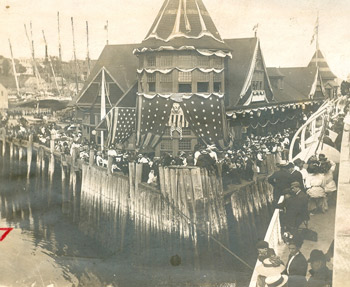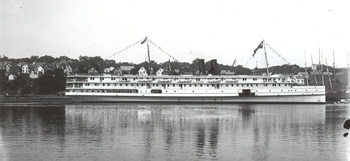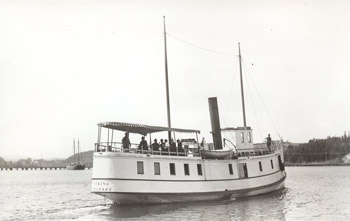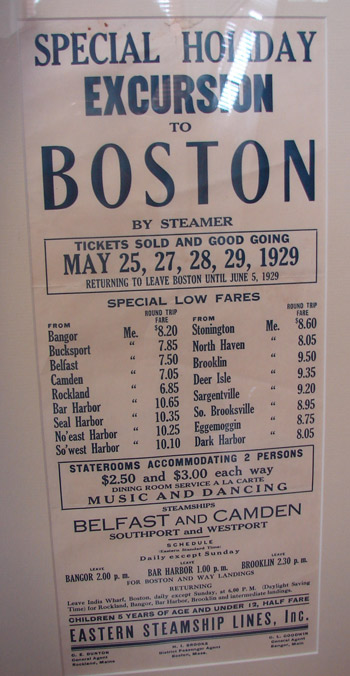The Boston Boats
Maine’s Golden Age of Steam Travel
by Tom Seymour

The new steamboat wharf circa 1900 at Belfast likely during the Fourth of July holiday. The city, vessel masts and horses are visible in the background. Larger steamboats had to back away from the wharf into deeper water in the bay in order to turn around. Photo courtesy Belfast Museum and Historical Society
Imagine traveling from Midcoast Maine to Boston without the stress of highway travel. No bumper-to-bumper headaches, no worry about parking and no need to stop and gas up. Better yet, the trip comes with amenities such as comfortable, elaborately-furnished staterooms, fine food and drink and a safe, relaxing atmosphere.
This was the way it was with steam travel, when people from various parts of Maine would make their way to the nearest steamship landing in the evening and settle in for the night-long ride to Boston. Waking up in the morning fully refreshed was another benefit of this mode of travel.
Steam travel was a well-established and accepted mode of transportation by the time the two steam vessels Katahdin and Cambridge began their twice-weekly runs between Bangor, Maine and Boston, Massachusetts in the year 1875. For Maine, this heralded the beginning of the golden age of steam travel.
Later that same year, the steamer The City of Richmond began running between Bangor and Portland. Then during the summer months The Pioneer commenced with runs between Bangor and Brooksville. And in the fall, the May Field made the same run, which also included connections with other boats, thus offering unlimited travel opportunities for Mainers.
These ships, known collectively as the Boston and Portland steamers, included the Katahdin, Cambridge, Richmond and later, a Carter & Company ship built in Belfast named May Queen and soon after, a ship named The Planet. The company at that time was called the Merchant’s and Mechanic’s Steamboat Company.
Over the years, vessels were added to the stable of boats and ships owned by a new company, the Sanford Steamship Company (notice the change from the previous name, “steamboat” to “steamship”) and in 1882, the company changed its name again, this time to The Boston and Bangor Steamship Company. All of these ships were collectively now known as the Boston Steamers or, colloquially, the Boston Boats.

The steamship Belfast at Belfast 1929. The Belfast was launched at Bath Iron Works on November 17, 1908 and in June of 1909, Belfast made the trip from Bath to Belfast, from whence for the next 26 years the triple-screw steamship and her smaller sister ship, Castine, would offer overnight trips to Boston. Photo courtesy Belfast Museum and Historical Society
Rail And Water
During the heyday of the Boston Steamers, travel by road was difficult and tedious. Mud, dust and generally bumpy, poor conditions prevailed. But even people living far inland had easy access to the Boston Boats, as long as they could make their way to the nearest railroad station.
From there, the trains shuttled passengers to the various ports, where they could book passage on any number of steamships bound for a wide variety of destinations. This system, though now obsolete and antiquated, gave people of the day something few had access to up until then, that being unrestricted freedom of travel.
It seems likely that people of today who don’t drive or own an automobile, are hardly better off than those who lived in the halcyon days when steam ruled. In fact, people in the old days probably had it better when it cam to long trips. Travel by first rail and then water was comfortable and available to all.
Here’s a bit about the old steamboats that many may not realize. All these boats were rigged with two short masts, fore and aft. This was done to allay fears on the part of passengers who were still more used to travel by sail. But in fact, in the case of engine failure, these inconsequential sails would have contributed little to a boat or ships’ forward progress. It seems probable, though, that judicious use of these sails might have helped maintain a straight course by preventing sideways slippage in heavy winds.

Smaller steamboats made shorter regional runs. This wood steamboat was of a common size along the Maine coast. Passengers and cargo were shuttled beginning in the 1870’s. Photo courtesy Belfast Museum and Historical Society
Pleasure Cruises
Business travelers were not the only clients on the Boston Boats. Special excursions for pleasure became a popular item in the late 1800s and continued to the end of the age of steam travel. In 1884, the Emmeline steamed out of Belfast, making excursions on the upper regions of Penobscot Bay. Emmeline also made weekly trips between Belfast and Swan Island and in season, from Belfast to the camp-meetings in Northport.
One advertisement in a Maine newspaper solicited passengers for “Summer trips on the salt water.” The ad went on to say, “Splendid steamships and first-class service. Why not make your summer travel a part of your vacation outing? The Eastern Steamship Corporation operates 15 lines of steamers, connecting the principal summer resorts of the Maine coast, and linking the Maine seaboard with Boston, New York and the Maritime Provinces. All equipped with wireless telegraph.”
As per specific destinations, often the steamship companies would plan special holiday excursions in addition to general pleasure trips. For instance, there was the special Fourth of July excursion on the Steamer Castine. The ship would pick up passengers from Searsport, Belfast, Northport Campground and Temple Heights and drop them off at Camden in order to partake of the Forth of July activities.
Great White Flyers
By the beginning of the 20th century, the Eastern Steamship Company’s ships were known as the “Great White Flyers.” This analogy was fitting and proper and the illusion of a great white structure flying over the waves still manifests itself in existing photos and paintings of the great steamships. Among the greatest of the Great White Flyers was the steamer Belfast.
The Belfast was launched at Bath Iron Works on November 17, 1908 and in June of 1909, Belfast made the trip from Bath to Belfast, from whence for the next 26 years the triple-screw steamship and her smaller sister ship, Castine, would offer overnight trips to Boston.
The twins berthed at the Eastern Steamship Company wharf at the foot of Commercial Street. At first the ships were far too large for the wharf, massive as it was, to accommodate them. So the wharf was modified to accept the twins. Even so, in order to turn around, both ships were compelled to back well out in the harbor where they found water deep enough to allow them to turn.
These steamships had steel hulls and multiple, watertight bulkheads. Continuous speeds of 17 knots and more were made possible by 4,000-horsepower steam turbines.
The Belfast featured a social hall, dining room and 204 staterooms. All were elegantly appointed, the social hall trimmed with mahogany and trimmed out in green and white. The Belfast also had 222 below-deck berths beneath the main deck. These were segregated into 135 berths for men and 87 for women.

Steamship poster for 1929. Photo courtesy Belfast Museum and Historical Society
End Of An Era
All things must end and so it was with the golden age of steamships in Maine. The Belfast left her home port for the last time on December 27, 1935 and in 1936, was sold to Colonial Navigation Company where she operated between Providence and New York. In 1942, the United States government purchased the Belfast and renamed her Arrow. She was then used as a transport ferry in Hawaii during World War II. Then on February 13, 1947, she broke her towline and went ashore at Ocean Park, Washington.
The ship was wrecked beyond redemption and from then on, remained nothing more than a memory to those who knew and loved her. Her whistle, however, currently resides in the Belfast Museum and Historical Society, where it is on exhibit.
Another Boston Boat ended up in service in China. A March 1965 article in Down East Magazine featured a letter from the last known person from Maine to see the Penobscot Bay steamboat Comet in operation. The name had been hastily painted over and replaced with the name Ya Sung, in both Chinese and English. The Ya Sung was last seen steaming down the Yangtze River, completely filled with local citizens and their domestic animals.
